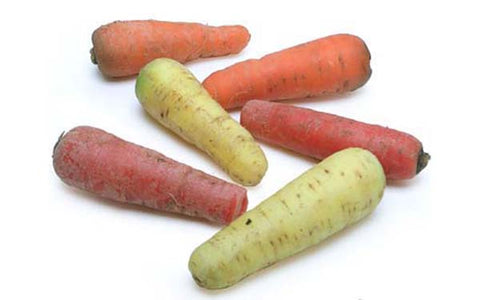A Bunch of Flavor
By Mark Mulcahy

Did you know that wild carrots are not naturally orange, but white, purple or yellow? In Central Asia, where carrots were first cultivated, purple and yellow ones grew wild—and still do. The Moors brought carrots to Europe when they invaded Spain. It was in Europe that their orange and red attributes were revealed, perhaps by crossing them with the wild white varieties. By the 13th century, orange carrots were widely grown. Today, yellow, green, red, and purple are back as specialty items. Their taste and texture are different - and worth trying!
Sweet and crunchy, carrots are the 2nd most popular vegetable in the world (after potatoes). Highly nutritious with good amounts of fiber, vitamin C, and some calcium, carrots are also loaded with the orange pigment carotene, which is converted into vitamin A in the digestive tract. Vitamin A is excellent for the eyes, and carrots grew in popularity in WWII when the UK’s Ministry of Food spread tales of British pilots eating them to improve their night vision.

When you walk through the produce department, there are always so many options for organic carrots to choose from: loose, baby, 1-5 pound bags – and they are all good for you and quite flavorful! However, my favorites during this time of year are the Melissa’s organic bunched carrots, as they just seem to be a little bit sweeter and a touch more tender.

When you buy your Melissa’s organic bunched carrots, look for carrots with no cracks or damage and bright green tops that look fresh and perky. Choose the ones with the brightest color, as the brighter the color, the sweeter the carrot – and of course a darker orange means more beta-carotene for you. When you get them home, cut off the greens before storing them in the fridge, as leaving them on robs the carrots of moisture and essential vitamins. You can store your carrots in the refrigerator in a plastic bag or a sealed container, and they’ll keep for 7 to 10 days. Make sure you keep them away from fruits such as apples and pears, as the ethylene gas those fruits release can make your carrots bitter. If you’ve kept your carrots around a bit you may notice a dry white coating or bloom on them - it’s not mold, but a sign of dehydration. You can take care of that by soaking your carrots in ice water for about 10 minutes. The white will disappear and they will regain their bright orange color.
A few more tips: first, always wash and scrub carrots before using, because they’re harvested directly from the soil. Peeling is a matter of choice, depending on your preference and the size of the roots you buy. Larger carrots can sometimes be bitter and if there is any bitterness it will be in the peel – so give ‘em a bite before you break out the peeler!

Did you know that wild carrots are not naturally orange, but white, purple or yellow? In Central Asia, where carrots were first cultivated, purple and yellow ones grew wild—and still do. The Moors brought carrots to Europe when they invaded Spain. It was in Europe that their orange and red attributes were revealed, perhaps by crossing them with the wild white varieties. By the 13th century, orange carrots were widely grown. Today, yellow, green, red, and purple are back as specialty items. Their taste and texture are different - and worth trying!
Sweet and crunchy, carrots are the 2nd most popular vegetable in the world (after potatoes). Highly nutritious with good amounts of fiber, vitamin C, and some calcium, carrots are also loaded with the orange pigment carotene, which is converted into vitamin A in the digestive tract. Vitamin A is excellent for the eyes, and carrots grew in popularity in WWII when the UK’s Ministry of Food spread tales of British pilots eating them to improve their night vision.

When you walk through the produce department, there are always so many options for organic carrots to choose from: loose, baby, 1-5 pound bags – and they are all good for you and quite flavorful! However, my favorites during this time of year are the Melissa’s organic bunched carrots, as they just seem to be a little bit sweeter and a touch more tender.

When you buy your Melissa’s organic bunched carrots, look for carrots with no cracks or damage and bright green tops that look fresh and perky. Choose the ones with the brightest color, as the brighter the color, the sweeter the carrot – and of course a darker orange means more beta-carotene for you. When you get them home, cut off the greens before storing them in the fridge, as leaving them on robs the carrots of moisture and essential vitamins. You can store your carrots in the refrigerator in a plastic bag or a sealed container, and they’ll keep for 7 to 10 days. Make sure you keep them away from fruits such as apples and pears, as the ethylene gas those fruits release can make your carrots bitter. If you’ve kept your carrots around a bit you may notice a dry white coating or bloom on them - it’s not mold, but a sign of dehydration. You can take care of that by soaking your carrots in ice water for about 10 minutes. The white will disappear and they will regain their bright orange color.
A few more tips: first, always wash and scrub carrots before using, because they’re harvested directly from the soil. Peeling is a matter of choice, depending on your preference and the size of the roots you buy. Larger carrots can sometimes be bitter and if there is any bitterness it will be in the peel – so give ‘em a bite before you break out the peeler!

